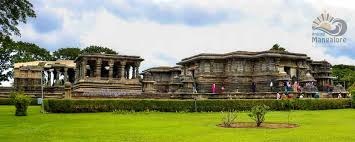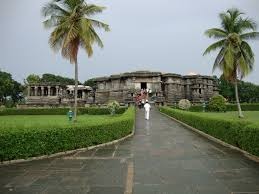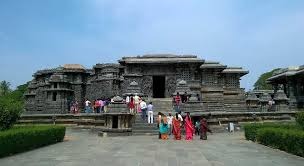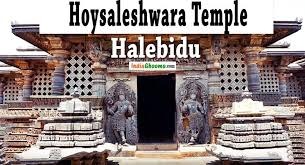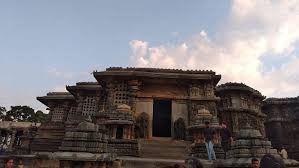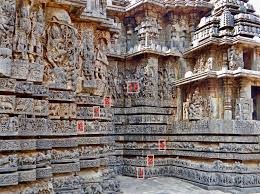Hoysaleshwara Temple: A Masterpiece of Hoysala Architecture
Tucked away in the quaint town of Halebidu in Karnataka, India, the Hoysaleshwara Temple stands as a magnificent testament to the artistic and architectural achievements of the Hoysala dynasty. Renowned for its intricate carvings and stunning design, this temple is a must-visit for anyone interested in history, architecture, and spirituality.
A Glimpse into History
Constructed in the 12th century during the reign of King Vishnuvardhana, the Hoysaleshwara Temple is dedicated to Lord Shiva. It was built by the Hoysala ruler as a grand display of devotion and architectural innovation. The temple's creation reflects the Hoysala dynasty's commitment to art and religion, making it an important historical and cultural landmark.
Architectural Brilliance
The Hoysaleshwara Temple is a prime example of Hoysala architecture, a distinctive style characterized by intricate sculptural work and unique design elements. Here are some highlights of its architectural splendor:
Star-Shaped Base
The temple is renowned for its star-shaped base, a signature feature of Hoysala architecture. This unusual design not only adds to the aesthetic appeal but also enhances the structural stability of the temple.
Intricate Carvings
The temple is adorned with elaborate carvings that cover almost every surface. The walls, pillars, and ceilings are intricately decorated with scenes from Hindu mythology, including depictions of gods, goddesses, celestial beings, and various mythological stories. The level of detail in these carvings reflects the extraordinary skill of the artisans who worked on the temple.
Twin Temples
The Hoysaleshwara Temple complex consists of two temples: the Hoysaleshwara Temple and the Kedareshwara Temple. Both temples are dedicated to Lord Shiva and are almost identical in design. This symmetry adds to the grandeur of the complex.
Dome and Pillars
The temple features a stunning dome supported by intricately carved pillars. Each pillar is adorned with detailed sculptures, depicting a range of deities and mythological figures. The craftsmanship of these pillars is a testament to the high level of artistry achieved during the Hoysala period.
Spiritual and Cultural Significance
The Hoysaleshwara Temple is not only an architectural marvel but also a significant spiritual site. It continues to be a place of worship and pilgrimage, where devotees come to offer prayers and seek blessings from Lord Shiva. The temple's serene atmosphere and beautiful surroundings provide a perfect setting for spiritual reflection and devotion.
Exploring the Temple Complex
Visiting the Hoysaleshwara Temple offers a chance to immerse yourself in the rich cultural heritage of the Hoysala dynasty. Key features to explore include:
-
The Main Sanctum: The central area where the main Shiva Lingam is enshrined. This sacred space is the focal point of worship and devotion.
-
The Carved Panels: Take time to appreciate the elaborate carvings on the walls, which include scenes from the epic Mahabharata, various deities, and intricate patterns.
-
The Pillared Hall: The temple's hall, supported by intricately carved pillars, is a highlight of the architectural design. Each pillar is unique and showcases the skill of the artisans.
Nearby Attractions
Halebidu is home to several other attractions that complement a visit to the Hoysaleshwara Temple:
-
Hoysala Architecture in Belur: The nearby town of Belur features the Chennakeshava Temple, another stunning example of Hoysala architecture.
-
Jain Temples: Halebidu and its surrounding areas also host ancient Jain temples, which offer additional insights into the region's religious and cultural history.
-
Nature and Scenery: The lush landscapes around Halebidu provide opportunities for leisurely walks and exploration, enhancing the overall experience of your visit.
Practical Tips for Visitors
-
Best Time to Visit: The cooler months from October to March are ideal for visiting Halebidu, as the weather is pleasant and conducive for sightseeing.
-
Dress Code: Modest attire is recommended, as the temple is a sacred site. Ensure that shoulders and knees are covered.
-
Local Etiquette: Respect local customs and traditions while visiting the temple. Maintain a quiet and reverent demeanor inside the temple premises.
-
Guided Tours: Consider hiring a local guide to gain deeper insights into the temple’s history and the intricate details of its carvings.
Conclusion
The Hoysaleshwara Temple in Halebidu is a stunning example of Hoysala architecture and a cherished cultural treasure. Its intricate carvings, unique design, and serene atmosphere make it a must-visit destination for those interested in exploring India’s rich architectural and spiritual heritage. As you wander through its hallowed halls and admire the detailed sculptures, you’ll gain a deeper appreciation for the artistic achievements of the Hoysala dynasty and the timeless beauty of this extraordinary temple.


